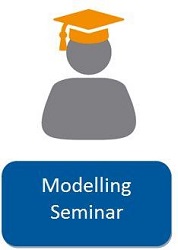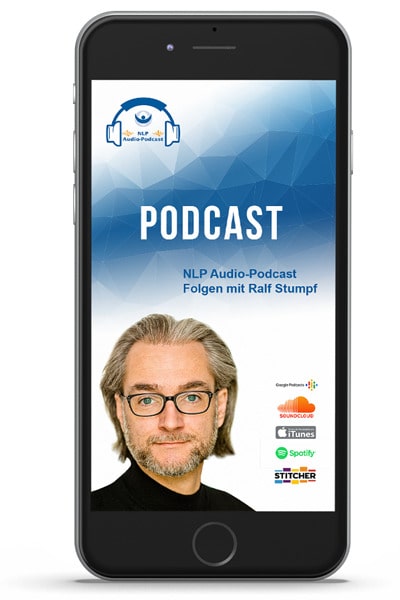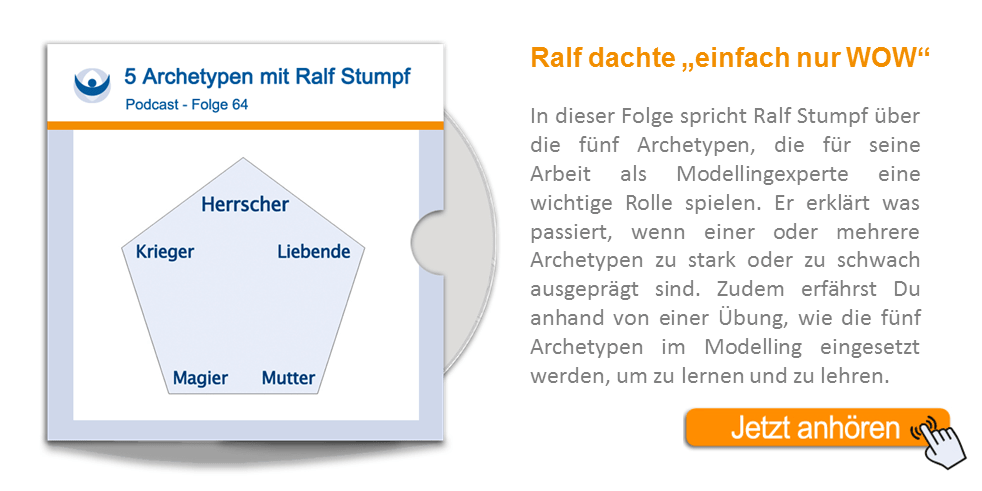NLP Modelling
Introduction to Modelling
Modelling is the original discipline of NLP. Looking back at the history of NLP, all of its strategies and techniques originated from observing top performers, breaking their excellence down into small chunks, and describing these in a way that allows others to reproduce them.
In our online academy, there is a 75-minute recording of an online seminar on this topic that you can watch in full length right away. Simply click on the button "Watch Video" to learn more.
Online Seminar - Modelling Weekend
This weekend is for people who want to understand themselves: only when you know who you are, can you know what you truly want!
Modelling is about understanding yourself and understanding others. Modelling is about learning from one another. And modelling is about recognizing your own strengths. Therefore, on the first day, we will take an NLP model, adapt it to you personally, develop a tailored reflection of your qualities, and then work with that model. On the second day, we will repeat the same process with other people – both with fellow participants in small groups and with external models.
As Robert Dilts says:
"NLP is the process by which the relevant behavioral components of those communicatively gifted individuals were discovered and organized into a working model.
... NLP has developed techniques and distinctions that allow the identification and description of patterns of verbal and nonverbal behavior.
... The goal of the NLP modelling process is not to produce the one true or correct description of a person’s thought process, but rather to create an instrumental map that allows us to apply the modelled strategies in useful ways."
According to Walker:
"Modelling seeks to represent a process conceptually so that others can practice and learn it."
Modelling can be carried out in many different ways. The range extends from unconscious and informal modelling (which we constantly do with others) to sophisticated and complex strategies for modelling excellence in various fields. Modelling is a natural process. Children intuitively model their parents and others, unconsciously learning complex behaviors, attitudes, and perspectives.
When modelling, it is crucial to determine the level or chunk size of the skills you want to focus on. Sometimes simple imitation or mirroring is sufficient for basic behavioral skills. However, this approach becomes ineffective when it comes to complex cognitive and linguistic skills.
The most commonly used NLP methods for eliciting modelling data are:
- Remembering and reliving a specific experience, or
- Performing a task that requires or triggers a particular skill, strategy, resource, or problem state.
For example, if someone is an excellent public speaker, you might:
- (a) ask them to recall a time when they gave a speech, or
- (b) ask them to stand in front of a group and start speaking.
Different terms are often used: the English "modeling," "modelling process," "model formation," or the German "Modellieren."
What Can Modelling Be Used For?
- Improving Metacognition:
To better understand something so that it can be taught more effectively. - Improving Performance:
To repeat and refine an activity until it becomes excellent – for example, athletes are closely studied to identify patterns of top performance. - Achieving Specific Outcomes:
Such as spelling, overcoming phobias, or treating illnesses by examining successful cases. - Transferring to Other Contexts:
Processes useful in one area of life can often be applied successfully in another.
Three Basic Perspectives in Modelling

Successful modelling observes a phenomenon or behavior from multiple perspectives. Here, the three perceptual positions from NLP Practitioner training are especially useful.
The first position represents your own perspective — the situation is experienced fully associated as yourself.
The second position is the other person’s perspective — you see and experience the situation as if you were them, dissociated from your own self.
In the third position, you are an uninvolved observer, taking an external viewpoint.
- Modelling from the first position means trying something yourself and noticing how “you” do it — seeing, hearing, and feeling from your own perspective.
- Modelling from the second position means stepping “into the shoes” of the person being modelled and attempting to think and act as they do. This can yield valuable intuitive insights into important but unconscious aspects of their thinking and behavior.
- Modelling from the third position means stepping back and observing objectively how the model interacts with others (including yourself). In this position, you suspend personal judgment and focus purely on sensory observation — like a scientist studying a phenomenon through a microscope.
- The fourth position is an intuitive synthesis of all these perspectives, providing a sense of the overall “gestalt.”
Implicit and Explicit Modelling
Competent performance can be described as a function of two fundamental dimensions: awareness (knowing) and competence (doing). It is possible to know or understand an activity but be unable to perform it (conscious incompetence). It is also possible to perform an activity well without knowing how one does it (unconscious competence). Mastery of a skill means both the ability to "do what you know" and to "know what you do".
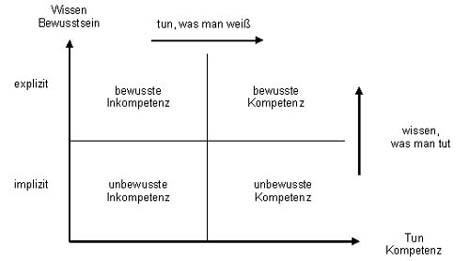
Cognitive and behavioral competences can be modelled either implicitly or explicitly. Implicit modelling means primarily stepping into the second position with the person being modelled to gain an intuitive personal sense of their subjective experience. Explicit modelling means taking the third position to describe the explicit structure of the role model’s experience so that it can be transferred to others.
| Implicit | Explicit |
|---|---|
| Experience - Intuition - Self-application (making the subjective experience from the second position tangible) unconscious, right hemisphere | Intuition - Structure - Transfer to others (defining the structure of the subjective experience from the third position) conscious, left hemisphere |
| General - The Whole | Specific - Parts |
| Synthetic | Sequential |
| State | Strategy |
| Associated | Dissociated |
| Inductive, intuitive, analog | Deductive, cognitive, digital |
| Child | Adult |
| External → Internal | Internal → External |
| Territory | Map |
Basic Phases of Modelling (from Dilts: Modelling with NLP)
The following basic phases of the typical NLP modelling process reflect the path from implicit to explicit modelling, which was already inherent in Grinder’s original suggestion to Bandler.
Preparation
Preparation for modelling includes (1) selecting a person who has the skill you want to model and (2) defining the following:
- the context in which the modelling will take place
- where and when you will have access to the person to be modelled
- the kind of relationship you want to have with the model
- the state you will be in while modelling
This also involves setting up the necessary conditions, anchors and “safety lines” that allow you to engage fully in the project.
Phase 1: Unconscious Uptake
In the first phase of the modelling process, involve the person being modelled in a relevant context that demonstrates the desired skill or ability. Begin modelling by entering the second position to intuitively sense the skills the person demonstrates. This happens without consciously searching for patterns. Instead, adopt the model’s posture and physiology and try to identify with them internally.
Sometimes it is better to mirror the model’s micro-muscle movements rather than their overt actions. The visible behavior represents the surface structure. Micro-movements and subtle adjustments from the second position will allow you to access the underlying deep structure. (Overt mirroring can sometimes distract the person being modelled.)
This is the “unconscious uptake” phase. Do not yet try to consciously understand what the model does. Creating filters too early can cause you to miss important information. You do not yet know what is relevant. It is often useful in this phase to adopt a “state of not knowing,” where all preconceptions are suspended to experience the situation freshly and without bias.
When you sense that you have developed an intuitive feel for the model in the second position, put yourself in a context where you can apply the skill. Try performing it “as if” you were the model. Then attempt to achieve the same results as yourself.
This provides you with a “double description” of the skill being modelled. If you achieve similar results as the model, the first modelling phase is complete.
Phase 2 – The Subtraction Process
The next step in the modelling process is distinguishing what is essential in the model’s behavior from what is not. (For example, you do not need to sit in a wheelchair or wear a purple robe like Milton Erickson to achieve similar therapeutic results with hypnosis.) In this phase, you begin explicitly formulating the strategies and behaviors you modelled. Since you can elicit similar responses as the person you modelled, you can now use your own behavior in the first position as a reference point — that is, performing the skill as yourself rather than “as if” you were the model.
Your goal is to clarify and define the specific cognitive and behavioral steps required to achieve the desired results in the selected contexts. During this stage, you will also systematically omit parts of each identified behavior or strategy to determine what truly makes a difference.
Anything you omit that does not affect the outcome is nonessential. If omitting something changes the result, you have identified an essential component. This procedure is known as the “subtraction process.” Its purpose is to reduce the modelled steps to their simplest and most elegant form — distinguishing the essential from the superstitious.
Once complete, you will have your current “minimal model” for reproducing the model’s abilities yourself (in your first position). You will also have intuitive insights from the second position gained by stepping into their experience, and a third-position perspective to compare your own reproduction of the skill with how the model naturally performs it. In NLP, this is called a “triple description.”
Phase 3 – Design
In the final phase of modelling, a context and procedure are designed through which others can also learn the modelled skills and achieve results similar to those of the model. For this design, you should synthesize the information gathered from all three perceptual positions.
Instead of simply imitating the individual steps taken by the model, it is usually more effective to create relevant reference experiences that enable learners to discover and develop the specific “wiring” they need for the skill to work properly. To acquire the skill, learners do not necessarily need to go through the same modelling process you went through.
Different learners will have different levels of conscious and unconscious competence as starting points. You should take this into account when designing your training. For example, if a procedure you modelled involves visualization, some learners may already do this easily, while for others it may be an entirely new concept. Some will be able to combine several steps into one, while others may need to break a single step into smaller sub-skills.
Once again: the guiding principle is the usefulness of your design for the learners for whom the model is intended.
Identifying Features in the Modelling Process
The main features or distinctions to observe during the NLP modelling process are:
- Physiology
Observe body structure, posture patterns, gestures, symmetry, movement style, eye movements, and other access cues such as tone and tempo of speech (the B.A.G.E.L. model). - Cognitive Strategies
Observe the preference for certain sensory representational systems, submodality patterns, and habitual cognitive sequences (the R.O.L.E. model). - Meta-Program Patterns
Observe general organizational patterns such as time perception and management, relationships with others, goal orientation, etc. - Belief and Value Systems
Observe expressed values, rules, attitudes, and presuppositions about the modeled behavior or skill. - Meta-Patterns
Observe the interaction between the person being modelled and others involved in the modelled situation. Notice patterns in communication and relationships between the model and others.
Of course, some of these distinctions will be more relevant for modelling certain skills than others.
Simple behavioral modelling, for example, will mainly focus on physiological patterns. Modelling simple cognitive skills, on the other hand, usually focuses on representational systems and submodalities. Modelling complex behavioral abilities emphasizes interactive meta-patterns, and so on.
The following list shows which NLP distinction categories generally correspond to the level of ability at the center of a given modelling project:
- Simple behavioral – specific physical cues and actions
- Simple cognitive – representational systems and submodalities
- Simple linguistic – meta-model patterns and predicates
- Complex behavioral – S.C.O.R.E. model distinctions and perceptual positions
- Complex cognitive – S.O.A.R. model distinctions, meta-program patterns, and logical levels
- Complex linguistic – communication matrix distinctions and Sleight of Mouth patterns
The R.O.L.E. Model
Information about this model can be found on the respective page: R.O.L.E. Model.
The B.A.G.E.L. Model
Information about this model can be found on the respective page: B.A.G.E.L. Model.
Steps of a Modelling Process
- Conduct a needs analysis to determine the specific topics, contexts, and skills to be addressed.
- Select the individuals to be modelled.
- Create modelling scenarios and carry out procedures to activate the desired skills and collect necessary information.
- Identify relevant patterns in the behavior, strategies, and beliefs of the individuals modelled.
- Organize the discovered patterns into a descriptive and instructional structure — a model.
- Experimentally test and refine the model by applying it in relevant contexts to verify that it produces the desired results.
- Develop effective implementation and intervention methods so that the model’s core elements can be taught or applied to others.
- Measure the outcomes obtained through the application of the model.
Summary of the Modelling Process Steps
We can summarize the basic phases of the NLP modelling process in the following sequence:
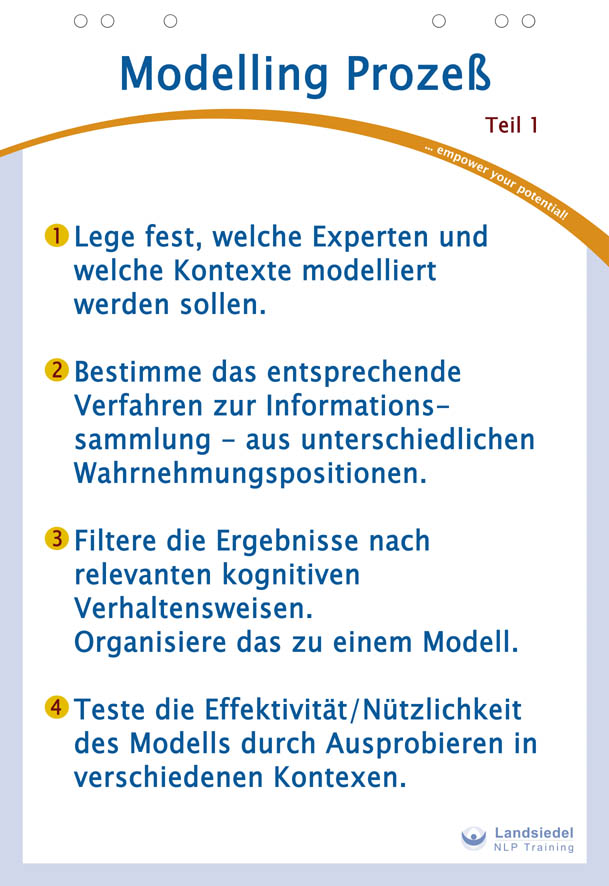
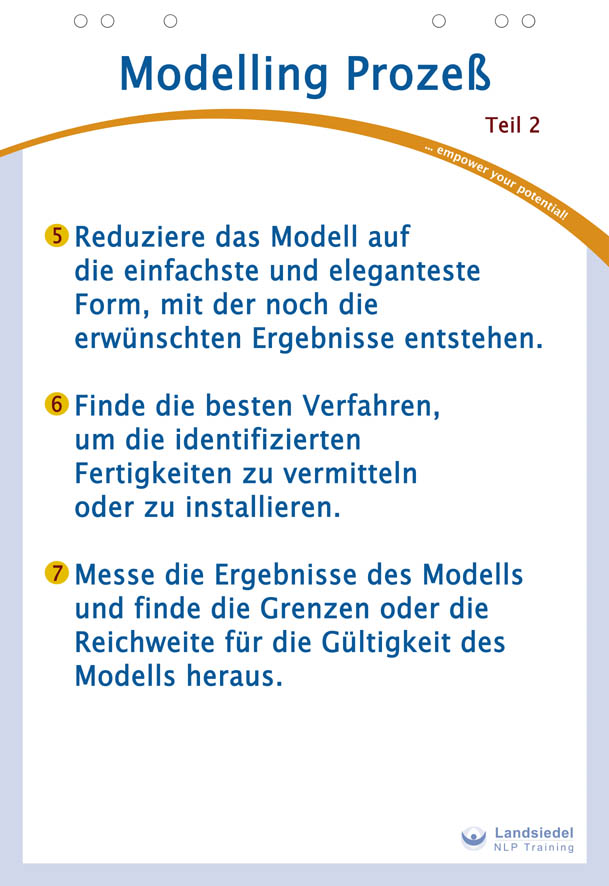
- Define which experts and in which contexts you want to model the desired skill.
- Determine the data-gathering procedure in those contexts from multiple perceptual positions. Begin with intuitive insights from the second position, then aim to achieve similar results from your own first position. Finally, adopt a third position to compare your approach with that of the model.
- Filter your observations for relevant cognitive and behavioral patterns. Organize these into a coherent, logical structure — a “model.”
- Test the effectiveness of the model by applying it in various contexts to ensure it consistently produces desired outcomes.
- Simplify the model to its most elegant and efficient form that still achieves the desired results.
- Develop optimal methods for teaching or “installing” the explicit skills identified during modelling.
- Determine the best tools for measuring the results and define the scope and limitations of the model’s validity.
Robert Dilts’ Modelling Strategy
- Define the desired skill or ability to be modelled and identify the person(s) who demonstrate it.
- Create a situation or context in which you can observe at least three specific examples of how the model demonstrates this skill.
a) Using the following perceptual filters, identify the critical factors in each example:
- Access cues
- Language patterns – Meta Model, predicates, etc.
- Physiology
- Representational systems, strategies, and submodalities
- Meta-program patterns
- Beliefs and values
- Logical levels
- Find at least one counterexample — a person or situation where the skill is not demonstrated effectively. Identify its critical factors using the same filters as in step 2a.
- Compare the critical factors from the successful examples with those of the counterexample(s). Note the significant differences.
- Modify all significant factors of the counterexample(s) to match those of the successful examples until the desired behavior or results are achieved. If this does not work, find better or stronger examples and repeat the process from step 4.
- Next, begin altering the critical factors one by one to test their impact.
a) Identify the limits by determining how far you can change a factor before it alters the outcome.
b) Apply the principle of elegance: find the minimal number of factors necessary to produce the desired behavior or results.

 Deutsch
Deutsch English
English Français
Français 中文
中文 Español
Español नहीं
नहीं Русский
Русский